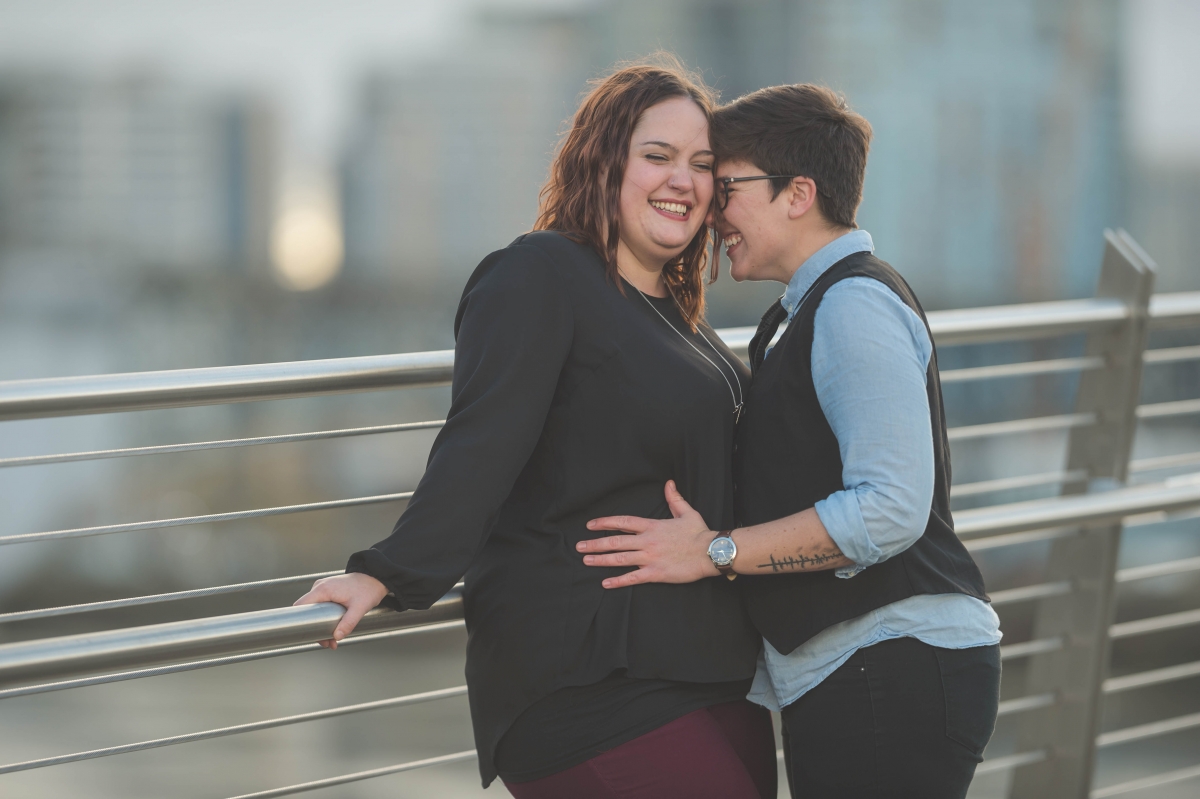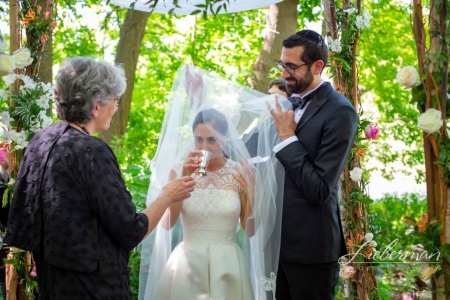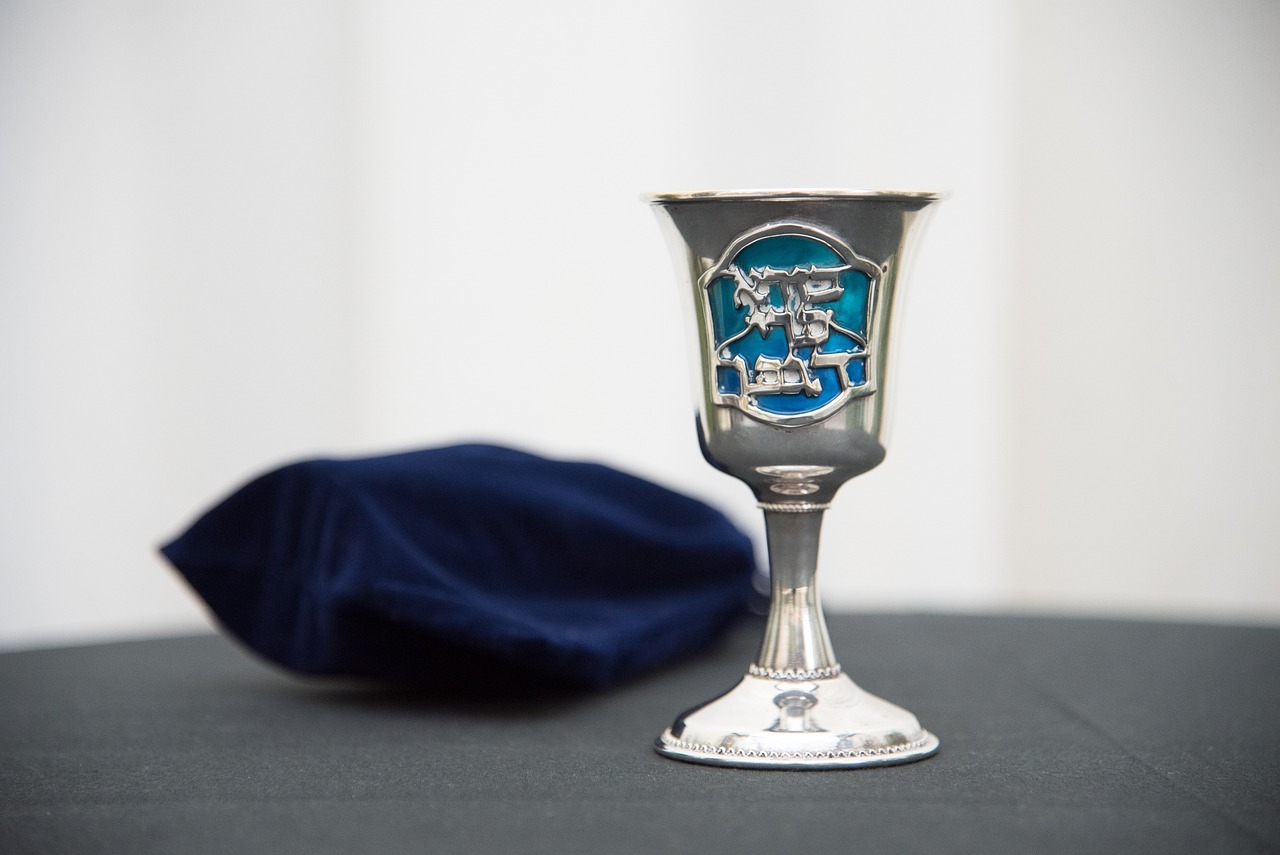Welcome to our wedding!
We’re so happy you are able to join us today! On behalf of the Schuster and Scheinberg families, we hope that today is as memorable and joyous an occasion for you as it is for us.
Part of the thrill for us (Kyra and Mike—a.k.a. “the bride and groom”) is that we are continuing traditions that have been observed by other Jewish couples throughout the centuries. While we are not engaging in some of the more “common” wedding traditions, such as throwing the bouquet, the throwing of the garter, or the throwing of rice (there sure is a lot of throwing!), we are participating in other traditions which make this a true kiddushin—a holy and sanctified partnership in the eyes of Judaism and the Jewish community.
We hope this guide will help you become more accustomed to these traditions. Share and enjoy!
Kabbalat Panim (aka: Greeting Faces)
This is the time that we get to formally greet our guests. You can either join Mike in the Small Chapel area or Kyra in the lobby.
A tisch is Yiddish for “table,” and is also the name of the ceremony in the Chapel. Here’s the logic of it: It’s customary for the prospective bride and groom to fast (at least ’til midday) because this day is a symbolic “Day of Atonement” for them as they end separate lives and start one together. In addition, during the prayer service preceding the wedding, the bride and groom both add several prayers of confession and penitence. After the recitation of the afternoon prayer (Mincha), the groom can eat and drink, so he shares this with his fellow guests and prayer buddies. Mincha will be led by Jason Schwartz, a friend of Kyra and Mike.
Ah, but what is a meal without words of Torah and Judaism to accompany it? Logically, the host of the tisch should be the one to say these words. As the groom is under enough stress as it is, the friends and family of the groom interrupt his words with laughter, songs, and more—mostly to ease the tension and get everyone in a joyous mood. Remember—all’s fair in love and games!
Ketubah
This is the Jewish marriage contract. It is one of the oldest elements in a Jewish wedding. It’s also pretty unromantic, as ketubot traditionally do not mention love, trust, the establishment of a Jewish home, or God. It’s simply a legal contract written in Aramaic text which gives the woman status and rights in the marriage.
The bride and groom do not sign the ketubah. Instead, at least two witnesses who are not related to the couple sign it. The requirements for these witnesses are simply that they uphold the Jewish laws and customs and can be trusted with such a great responsibility. We will be having four friends—Steve Kerbel, Daniel Turner, Melanie Darr, and Renée Cohen—sign our ketubah.
We invite you to sign the picture mat in the lobby, as we will be using it to frame the ketubah when we display it in our home. As we look at it, we will always remember this amazing day as well as our friends and family who helped make it so special.
Bedecken
Just to make sure that they are marrying the right people the groom and bride participate in a tradition called a bedecken, which literally means “checking.” This goes all the way back to our patriarch Jacob, who ended up marrying Leah instead of Rachel—simply because he wasn’t careful. Therefore, the groom always checks to make sure that he marries the right woman. (None of that soap opera switcheroo stuff here!)
Attire
Why is Mike wearing a robe? No, he didn’t forget his tux; it’s what we call a kittel. The weddlng day is a personal Yom Kippur (Day of Atonement) for the bride and groom. On this holiday one wears white to symbolize cleanliness and purity. The white clothing is an extension of this purity.
Both Kyra and Mike will be wearing white during the ceremony. An added bonus is that they’ll be able to spot each other right away—and not marry the wrong person (see Bedecken).
The Huppah
The “wedding canopy” we are standing under is called a huppah. It symbolizes God’s presence and the couple’s new home. It can be made from a prayer shawl (tallit), hand painted, or quilted. It is supported by four poles. The tallit we are using for our huppah belongs to Kyra’s father, Rick. Sarah Schuster, Maita Schuster, Rachel Jay, and Elizabeth Frankel Kost, first cousins of Kyra and Mike, will be carrying and placing the huppah for us.
Seven Circles
These circles indicate an intertwining of the bride and groom together as they begin a new life together. They make seven circles, symbolizing the seven days of creation. First, Kyra walks around Mike three times, Mike walks around Kyra three times, then they circle each other at the same time.
Erusin (Betrothal)
The wedding ceremony has two parts: Erusin, or betrothal, and Nisuin, or nuptials. Originally, these two ceremonies were performed as much as a year apart from each other; nowadays, they are performed on the same day.
Erusin consists of two blessings. The first one is over a cup of wine (the traditional Jewish symbol of joy) and the second is the traditional betrothal blessing, praising God for the sanctity of marriage. Kyra and Mike then drink the wine from a kiddush cup which was presented to Mike in honor of his bar mitzvah.
After these two blessings, Mike places a ring on Kyra’s finger and says, in Hebrew, “Behold; you are consecrated unto me with this ring in accordance with the laws of Moses and Israel.”
Kyra reciprocates as she places a ring on Mike’s finger, saying, in Hebrew, “You are betrothed to me forever, you are betrothed to me with righteousness, justice, kindness, and goodness. And you are betrothed to me in faithfulness.” This verse from the book of Hosea talks about the relationship between God and the Jewish people. Just as God betrothed himself to the Jewish people, so, too, are man and woman betrothed to each other.
The Wedding Bands
Jewish tradition allows a wedding band to be without engravings or stones. You see, the ring is a symbolic transfer of property, and having it stay plain makes the point absolutely clear that the marriage is occurring through the ring itself, and not through any special added goodies on the ring which could change its value.
Nisuin (nuptials)/Sheva Brakhot
After the ketubah is read aloud, the second part of’ the wedding ceremony takes place. The sheva brakhot, or seven nuptial blessings, are recited. Once again, we see the “seven” motif symbolizing the creation of the world. Here are rough explanations of the seven benedictions that our friends and family will be reading:
Blessed are You, Lord, our God, Ruler of the Universe:
- who created wine (which we use to celebrate Jewish moments).
- who created everything for God’s glory.
- who fashioned humanity.
- who fashioned humanity in God’s own image and likeness.
- who brings joy to Israel through children.
- who helps make the new beginning for the couple as joyous as the Garden of Eden.
- who gives us joy and happiness through the uniting of bride and groom, and giving us the power to express our joy.
The Breaking of the Glass
There are a number of theories on this. Here are the top three:
- This gives the big cue to the congregation to shout “MAZEL TOV!”
- It symbolizes the destruction of the Temple in Jerusalem. (“We’re Jewish, why should we be happy at every occasion?”)
- This represents how fragile a relationship can be. By breaking the glass, we are reminded that the relationship should stay intact.
Yichud
No, no, Kyra and Mike are not in “time out,” they are just, um… “celebrating” their marriage. It’s called yichud, Hebrew for “together.” One would like to think that we are just hiding, or avoiding sloppy kisses from relatives and the whole reception line thing. Most likely, we are having a little nosh, a little wine, and letting the reality of what just happened sink in. Our friends Rachel Sternberg, Mary and Rich Klenk, and Mike Mulvaney will make sure we are not disturbed.
Se’udat Mitzvah (the wedding feast)
After some time to schmooze with everyone, nosh on some hors d’oeuvres, and comment on the wedding ceremony, we’ll be entering the se’udat mitzvah—a feast with lots of food, singing, dancing, and celebrating. Rather than having a first dance to “We’ve Only Just begun,” we celebrate by dancing around the bride and groom and their families. You’ll also see that we do not have a “head table” for the bridal party; instead, Mike and Kyra will be sitting at their own table for two.
The motzi, the traditional prayer of thanks before the meal, will be recited by Steve and Sima Schuster, Kyra’s uncle and aunt. Then—on with the festivities!
The celebration will conclude with birkat hamazon, the traditional Jewish grace after meals. This one has a few paragraphs thrown in celebrating the new marriage! Birkat hamazon will be led by Rabbi Naomi Kalish, Mike’s sister-in-law. Once again, we recite the sheva brakhot, led by friends Jeff Zirulnick, Rachel Sternherg, Steve Kerbel, Elissa Malter, Melanie Darr, and Renée Cohen. Thank you for celebrating with us on this special occasion! We look forward to sharing many simchas with you in the future.
We invite you to take a look at our wedding program on the web at www.kyra-mike.net/wedding/wedding-program.html We hope it enriches your knowledge about Jewish wedding customs. If you would like to use any of our explanations and descriptions for your wedding or for any other purpose, please email mike@kyra-mike.net with the details of your request.













